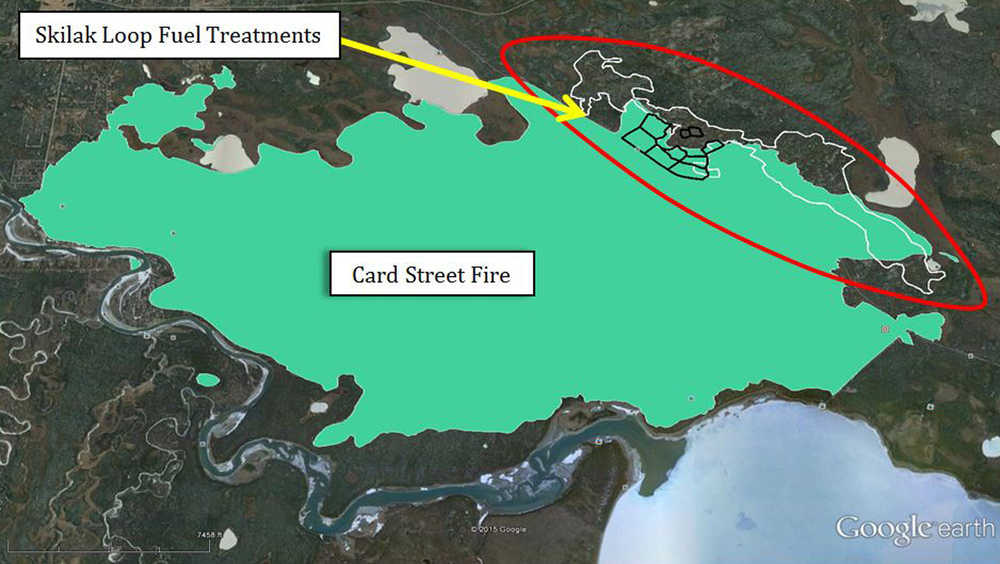On June 17, 2015 the Card Street Fire, fueled by strong westerly winds and very hot and dry conditions, became extremely active and made a significant push to the north and east. It was a continuous line of fire burning in the tops of trees, with flames in excess of 100 feet long. Embers being lofted into the air by the tremendous convection column created by these extremely hot conditions can potentially land up to 2 miles in front of the flaming front and start new fires.
With these conditions, there is nothing that firefighters can do to stop it. It is a runaway freight train. The only options available are to play defense by protecting structures out in front of the fire, and waiting for either the forest characteristics or weather conditions to change to bring the fire back down to a level where firefighters can re-engage in fighting it.
The news is not all bad, though. Way back in 1984, when the new movie “Gremlins” was making its rounds in local theaters, the Kenai National Wildlife Refuge conducted a “fuels treatment” in what has since been renamed the Skilak Wildlife Recreation Area. Huge machines called LeTourneau tree crushers were deployed to masticate about 600 acres of dense spruce forest and create openings in order to improve the overall habitat for moose. In 2009, using more modest equipment, another 100 acres was cleared of spruce in the same area, this time for the purpose of creating a site for wildlife viewing.
Fast forward over 30 years and it turns out these treatment areas influenced how and where firefighters were able to contain the Card Street fire. By removing the old spruce-dominated tree cover, new “pioneer” species of trees and brush quickly shot up with birch, aspen, poplar, and willow being the most common.
Although not a direct replacement for natural fire, in a way these treatments mimic what would occur after a forest fire. Spruce forests burn with varying intensities, and typically some areas are completely scorched while others experience less severe effects. The first vegetation to come up to replace the dead spruce in the scorched areas after a fire are these pioneer species. Leafy, deciduous trees and shrubs are associated with much less intense potential fire behavior than the spruce forests.
The Skilak fuel treatments provided one of the two conditions necessary to help subdue the Card Street Fire. These treatments changed the forest from primarily spruce to a mix of the leafy pioneer species. The fire marched to the north and east until it hit the Skilak Loop Road.
On the other side of the road, due to the fuels treatments, there was no longer a continuous canopy cover of spruce for the fire to consume. Instead, the fire dropped down from the tree canopy and remained on the surface. Flame lengths of 100 feet plus were now between 2-5 feet tall. Embers were no longer able to be launched miles ahead to start new fires. Firefighters took advantage of the change and were able to contain the north and east portions of the Card Street fire in these areas. Had the treatments not occurred, it is very likely that the fire would have continued to burn under extreme conditions through the continuous canopy cover of spruce that would have been present.
Both natural and man-made disturbances can be effective at maintaining healthy ecosystems. In coordination with our partners on the Peninsula, the Refuge continues to plan and implement both mechanical and prescribed fire treatments for the purpose of reducing fuel loads in strategic areas of the wildland-urban interface. Although resource management by humans is far from perfect, here on the Kenai Peninsula we believe that using several approaches to mimic natural disturbances at strategic places is the best option for attempting to balance the often conflicting needs of humans with ecosystem health.
Nathan Perrine is the Fire Operations and Prescribed Fire Technician at the Kenai National Wildlife Refuge. You can find more information at http://www.fws.gov/refuge/kenai/ or http://www.facebook.com/kenainationalwildliferefuge.

